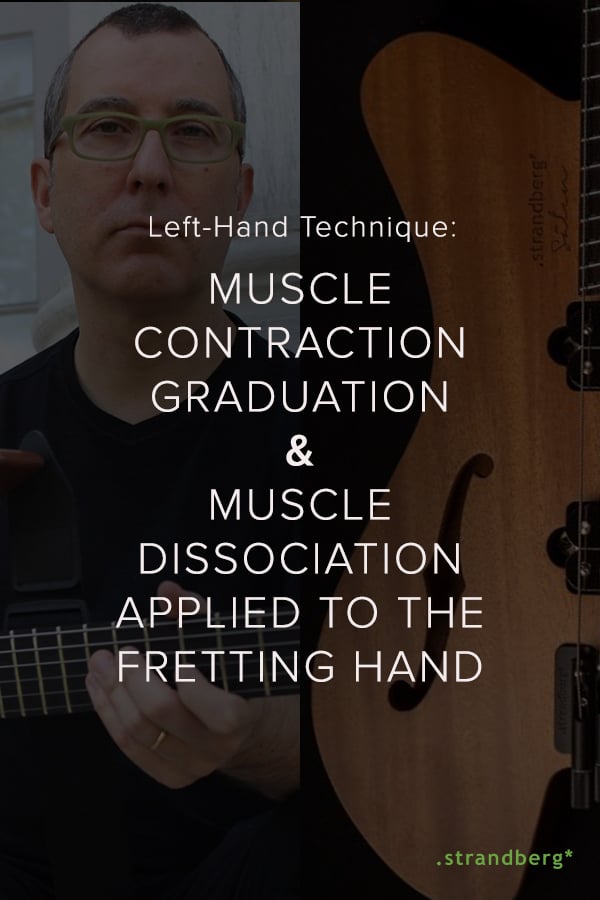I’m honored for being invited to write my first article for the .strandberg* Magazine. For this one, I’d like to explain two different techniques I combine on my left hand (fretting hand): Muscle Contraction Graduation and Muscle Dissociation. The names sound complicated, but the actual techniques are not too difficult to understand. The first musician I heard talking about these techniques was the composer and pianist José Alberto Kaplan (1939-2009) when he visited UFSM (Universidade Federal de Santa Maria, Brazil) when I was attending college. His lecture about piano technique was so inspiring and helpful that I had to start thinking about how to apply these piano techniques to the guitar.
There are some important details about the fretting hand that are unknown to many guitarists. Knowing these techniques can be useful to improve endurance, accuracy, and independence, and will help to avoid injuries from playing guitar.
Technique:
Before explaining these techniques, I have a question for you: What is the definition of the word “technique”? Can you explain it in one sentence?
…
(Think for a few seconds before continuing reading the article.)
…
I’ll share my definition so you can compare it with yours. I consider technique to be:
“The best and most effective way to do something that requires physical ability in a short period of time and spend the least amount of effort possible.“
Muscle Contraction Graduation:
I’ve heard many people say that in order to play the guitar, it is necessary to be fully relaxed. I don’t think this idea is 100% accurate as it’s impossible to make any movement without contracting and extending muscles. The big secret here is how to control the amount of energy that these muscles need to execute the movement needed to produce clean notes. The Muscle Contraction Graduation technique will help you achieve that. I’ll try to explain it here in a few words.
Any kind of contraction on the fretting hand needs to be adjusted until we can find the perfect point of contraction. In other words, the “sweet spot”. We should not contract the fingers more than it is necessary so that the notes we are playing can sound accurate. You’ll need to learn how to get to the sweet spot! Try the following:
- Place your left-hand finger one (index) on any fret or string. Just rest your finger on the string without pressing it.
- Then, start playing on the same string with the right hand while that same finger slowly starts contracting until the point that you can hear the note ring. Remember, this process is slow. No rush. It won’t work otherwise!
- When you find that sweet spot, stop contracting the finger, as you already have the necessary contraction needed to hear the note. That’s the sweet spot you should look for! Be aware of that specific moment and try to remember “I don’t need to push the string any harder in order to produce a clean sound!”. Repeat the process with the remaining fingers. Try random places and different strings.
Muscle Dissociation:
There is another technical approach I use all the time. It’s called Muscle Dissociation. How does it work?
For example, if we are using the third finger when we play a note, the rest of the fingers (1, 2, and 4) may be relaxed, except the third finger, which is already contracted. This concept is mainly applied to single notes like when you are playing scales and arpeggios. To actually incorporate this approach in your playing, you’ll need to practice it slowly at first and you must repeat the process with each finger individually. It is very important to try not to lift your resting fingers from the fingerboard when practicing this approach.
If we keep the other fingers raised and contracted, we will use the extensor muscles, which is going to be a waste of energy.
My advice:
When I was learning these techniques, I repeated this process for a few minutes every day before practicing or performing for a whole week. By doing that, I got used to the right amount of energy and control I need to play! Not more, not less: just the right amount. Try maybe 7 to 10 minutes a day of this and you won’t regret it. I’ve personally taught hundreds of students throughout the years and the vast majority of them incorporated these approaches into their styles.
More advice:
Here are some other personal tips to improve your technique:
- Don’t use a very high setup of the strings’ action. Even if you get a little more sustain, you will force your fingers too much. I like low action without frets buzzing.
- My truss rod setup doesn’t have almost any relief. It’s a personal choice. It doesn’t work for everybody.
- Remember to gently stretch your hands, neck, and arms before practicing and before a performance. This can help you warm up and can prevent injuries.
- Keep in mind that all instrumental technique is mental. In other words, your fingers don’t decide by themselves. You have to teach them. 🙂
Combining these techniques will bring your playing to the next level. Have fun!
———————————————————————————————————
Gustavo Assis-Brasil is a Brazilian-American guitarist, composer, educator, and author based in Boston, USA. He has written five books on hybrid picking and has taught clinics at USC, Berklee College of Music, Musicians Institute. Gustavo has used .strandberg* guitars since 2015.
For books, transcriptions, and much more, please visit Gustavo’s website at www.GustavoAssisBrasil.com
If you want to learn more about these approaches and many others, please check Gustavo’s “Jazz Guitar” instructional video series from My Music Masterclass.















Share this: